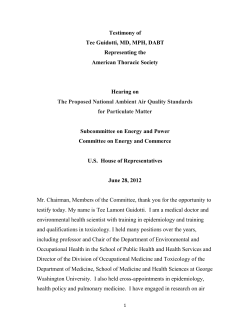
TITLE CEHN Articles Of the Month, December 2013 Issue ABSTRACT
CEHN Articles Of the Month, December 2013 Issue TITLE Ambient air pollution and low birthweight: a European cohort study (ESCAPE) AUTHOR(S) Marie Pedersen, Lise Giorgis-Allemand, Claire Bernard, Inmaculada Aguilera, Anne-Marie Nybo Andersen, Ferran Ballester, Rob MJ Beelen, et al. ABSTRACT Background: Many studies indicate that both prenatal exposure and postnatal exposure to high levels of ambient (outdoor) air pollution can cause adverse health effects in children and infants. Ambient air pollution has been associated with respiratory problems, asthma exacerbations, and asthma hospitalizations, and deficits in lung growth. Recent studies suggest that maternal exposure to ambient air pollution can increase the risk of preterm birth, congenital malformations, and restricted fetal growth. Infants who have a low birth weight are a greater risk of mortality, morbidity, and developmental problems than are infants with a higher birth weight. Objective: This study assessed the effect of maternal exposure to low concentrations of ambient air pollution on birthweight. Methods: The study population data was obtained from 14 population-based mother-child cohort studies in 12 European countries. Overall, the study population included 74,178 women who had singleton deliveries between February 11, 1994 and June 2, 2011, and for whom information about infant birthweight, gestational age, and sex was available. The primary outcome of interest was low birthweight at term, defined as a weight less than 2500 grams at birth after 37 weeks of gestation. Level of exposure to ambient air pollution was assessed via the following measurements: Annual mean concentrations of particulate matter with an aerodynamic diameter of less than 2.5 μm (PM2.5), less than 10 μm (PM10), and between 2.5 μm and 10 μm during pregnancy were estimated at maternal home addresses, along with black carbon (as measured via PM2.5 absorbance), nitrogen dioxide (NO2) and nitrogen oxides (Nox). In addition, traffic density on the nearest road (vehicles per day), and total traffic load (sum of the lengths of each road segment multiplied by the traffic intensity on all major roads within 100 meters of the residence) were estimated and included in the study. Results: The study found a statistically significant association between a 5 μm/m3 increase in concentration of PM2.5 during pregnancy and an increased risk of low birthweight at term. In fact this increased risk was also seen at concentrations lower than the present European Union annual limit of 25 μm/m3. The study authors estimate that a reduction in PM2.5 concentration to 10 μm/m3 during pregnancy would correspond to a 22% decrease in cases of low birthweight at term. While not statistically significant, associations were also found between risk of low birthweight and measures of PM 10, NO2, and traffic density on nearest road. Conclusion: Exposure to ambient air pollutants and traffic during pregnancy is associated with increased risk of low birthweight at term. POLICY IMPLICATIONS This large-scale study’s findings are consistent with that of previous research showing associations between poor ambient air quality and low birthweight. Although national health based standards have been promulgated under the U.S. Clean Air Act, many urban areas continue to be plagued with disproportionate levels of air pollution. For example, in 2012 approximately 28.2 million people lived in counties where PM2.5 concentrations exceeded standards. Many of these “hot spots” are located in low income and minority neighborhoods adjacent to highways or polluting industries. Improving and expanding the pollution monitoring network and improving regulation compliance, especially in the communities where our most vulnerable populations reside, may reduce the number of babies born with low birthweight and resultant health and developmental effects. These findings also raise the possibility that efforts to address other current public health challenges (such as obesity and climate change) -- such as more walkable and bikeable communities and decreased reliance on fossil-fuel powered motor vehicle travel -- may have the side benefit of decreasing the risk of low birthweight. REFERENCE Article available in The Lancet Respiratory Medicine. KEY WORD(S) Air pollution, Low birthweight 110 Maryland Avenue NE #402 • Washington, DC 20002 • 202.543.4033 • Fax: 202.543.8797 • cehn@cehn.org • www.cehn.org
© Copyright 2025





















